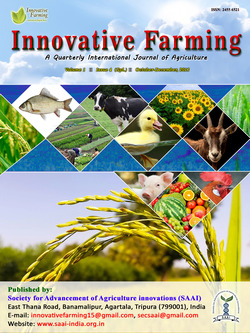
Dairying as Sustainable Livelihood Enterprise for Weaker Sections
Narmatha, N.*
Department of Veterinary and Animal Husbandry Extension Education, Veterinary College and Research Institute, Namakkal, Tamil Nadu INDIA
K.M. Sakthivel
Department of Veterinary and Animal Husbandry Extension Education, Veterinary College and Research Institute, Namakkal, Tamil Nadu INDIA
V. Uma
Department of Veterinary and Animal Husbandry Extension Education, Veterinary College and Research Institute, Namakkal, Tamil Nadu INDIA
M. Jothilakshmi
Department of Veterinary and Animal Husbandry Extension Education, Veterinary College and Research Institute, Namakkal, Tamil Nadu INDIA
S. Karthikeyan
Department of Veterinary and Animal Husbandry Extension Education, Veterinary College and Research Institute, Namakkal, Tamil Nadu INDIA
DOI: NIL
Keywords: Dairy farming, livelihood, financial security, participatory approach
Abstract
Action research was conducted in the Elangiyanur and Samireddipalli villages of Cuddalore and Vellore districts of Tamil Nadu, having highest weaker section and high dairy animal population. Dairying is the livelihood for majority of the farmers in the study area. A total of 100 farmers with dairy animals were selected through participatory approach involving rural local government system. Interventions were carried out in the feeding domain by introduction of proven scientific dairy farming practices and providing inputs such as concentrate feed for 100 days feeding contract, leguminous fodder seed (Hedge Lucerne), mineral mixture, TANUVAS GRAND. Usage of unconventional feed resources (brewery waste and azolla) and preparation of own concentrate feed were also promoted. Economic impact noticed were increase in quantity of milk production by 0.863 and 0.901 liters; increase in quality of milk i.e. fat content by 1.08% and 1.07% and SNF by 1.24% and 1.15%; cultivating green fodder had increased by 24% and 16%; azolla cultivation adopted by 46% and 58% ; conception rate improved by 70.2% and 71%; inter calving period reduced 43% and 47%; average feed cost /day/ animal / litre of milk was reduced from Rs.25.51/- to Rs.13.41/- and Rs.14.75/- to Rs.8.52/- of the beneficiaries in Cuddalore and Vellore district respectively. By adoption of scientific dairy farming technologies, a beneficiary is able to get an additional monthly income of Rs.2070/- in Cuddalore district and Rs.2490/- in Vellore district. Scientific interventions ensured social and financial securities to make dairy farming a sustainable livelihood option.
Downloads
not found
Reference
Jaiswal, P., H. Chandravanshi, and A. Netam. 2018. Contribution of dairy farming in employment and household nutrition in India. International Journal of Avian & Wildlife Biology. 3(1): 78‒79.
National Sample Survey Office. 2014. Key indicators of land and livestock holdings in India. Ministry of Statistics & Programme Implementation, Government of India.
Paroda, R.S. 1998. Indian dairy industry in the emerging scenario. Keynote address delivered at XXIX Dairy Industry Conference, 28th November, 1998. Karnal: Indian Dairy Association (North Zone).
Patel, R.K. 1993. Present status and promise of dairying in India. Indian Dairyman, 45(7) (July): 276-308.
